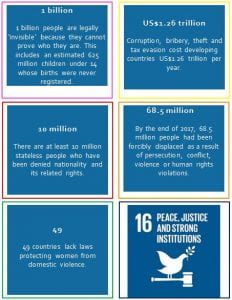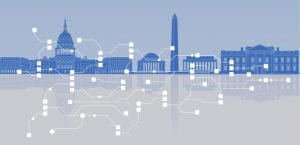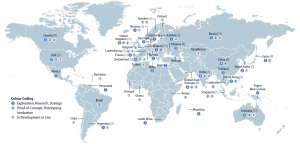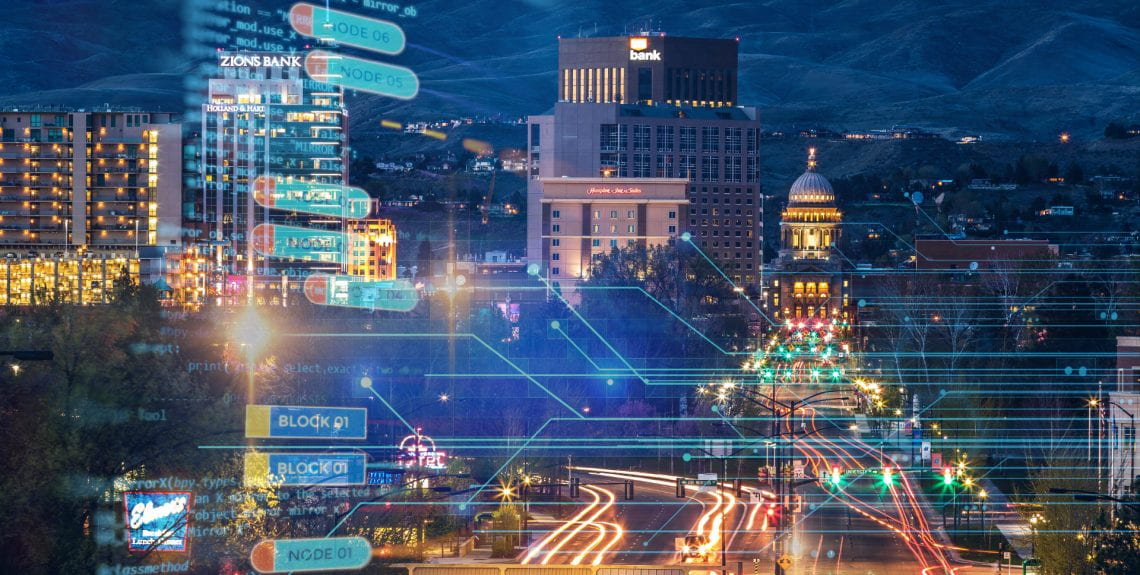GOAL #16: PEACE, JUSTICE, AND STRONG INSTITUTIONS
What is it? SDG 16 promotes peaceful and inclusive societies for sustainable development, providing access to justice for all and building effective, accountable and inclusive institutions at all levels.
How does it compare with other sustainability goals? Each of the SDGs are closely inter-linked, and Goal 16 works through providing support for others like poverty alleviation, climate change, reduce inequalities, and helping economies prosper.
Why do we need it? Let’s look at some facts to answer this question.

Our world is getting increasingly divided with some regions enjoying peace, security and prosperity, while others are falling into endless cycles of conflict and violence. Armed violence in particular have a destructive impact on a country’s development, thereby affecting economic growth and often resulting in grievances that lasts for generations and perpetuates other forms of violence.
As such, we cannot hope for sustainable development without peace, stability, human rights and effective governance, based on rule of law. Goal 16 aims to significantly reduce all forms of violence, and work with governments and communities to end conflict and insecurity.
To go through the targets of Goal 16, please click here.
Existing Infrastructure and urgent need for Innovation: Various UN institutions like UNDP (United Nations Development Programme), UNICRI (United Nations Interregional Crime and Justice Research Institute), and UNESCO (United Nations Educational, Scientific, and Cultural Organization) are all working towards the goal with different targets, such as freedom of media and safety of journalists, improving international policies on crime prevention and justice, preventing and countering violent extremism amongst others.
There are also technology led solutions being worked on small scale such as the UNDP’s Kosovo Small Arms Control Project (KOSSAC). It provides advanced technical equipment to the Kosovo Police like bullet recovery system, tracing database, and an ammunition identification database to help fight crime (50% of Kosovo’s households still possess firearms). However, compared to other SDG’s much is left to be desired in terms of innovative solutions through technology.
Block Chain
The most common example of blockchain technology for us in our time is of bit coin. While this usually invokes mixed reactions in people, there is immense value in the underlying technology, especially in the achieving the UN sustainability goals. At its core, blockchain is a crowd maintained real-time ledger that can be used to record information on financial transactions, contracts, physical assets etc. Pretty much any data can be included in a block chain. The ledger is distributed among users in a network that remains open, allowing everyone to see details of each record (called a block). The only person that can edit a block is the one who owns it and access is given using a private key that only the owner of a block has. Any changes made to an individual block trickles down the block chain and is distributed among all users, updating information in real time.
Blockchain and Goal 16?

Specifically, in the context of achieving the goal of Peace, Justice and Strong Institutions, using blockchain increases the level of transparency and trust into information sharing between institutions and public. This is because of the advantages this technology provides.
The biggest advantage of using blockchain is its immutability. It is impossible for anyone to change past data, without detection. This ensures the sanctity of data is maintained and the entire network has access to secure data. Another key advantage is it is time stamped. This adds an extra level of validity to the data stored which can be referenced back to and verified. The quality of data in a blockchain is stronger because it is verified by multiple users before it gets included in the blockchain. These blocks are digitally signed by users, making people accountable for the quality of information stored.
Game changer for public services
Blockchain technology can be incorporated into public services and can change the way social welfare is delivered, irrespective of geography. It can also interconnect institutions to consolidate information in one place, helping with promoting the goals of peace and justice, while strengthening individual institutions.
Identity management – According to the UN, about 1.1 billion people globally do not have any official ID at all, of which 440 million are children under the age of 18. This prevents people from being eligible for basic financial aid, government assistance, employment, health care provision, education, housing and employment. Without these basic public services, people can descend into poverty traps that are hard to get out of. Children especially are more prone to forced labour, trafficking and early marriage or sexual abuse as a result. In the current political climate, a problem of lost identity exists among refugees who have an even harder time surviving because they are unable to get access to the aid, they need in addition to being displaced from their homes, creating a lot of social imbalance.
A blockchain based ID can solve all these issues. By linking each block to a set of biometrics, a unique ID can be given to each person, who can access and track it from anywhere, allowing them to gain access to the services they need. It also ensures privacy for each individual user and traceability for governments who can track welfare better and ensure help reaches those in need. These unique IDs can also help governments in matters of taxation, voting and customs, further strengthening the entire system.
Land ownership and registry –More than 60% of civil disputes and legal cases are about property disputes, representing a significant amount of time and resources involved. This can create a drag on the economy, having larger effects through society. This mainly arises because of compromised paper-based records that are often not enough to prove ownership, leading to disputes. Blockchain solves this issue by storing property records certified by governments for use by users, verifying ownership and immediately helping with alleviating pressures off the justice system.
Consolidation of information across institutions – Government information on its citizens is still mainly in paper form and isn’t digitised. While efforts have been made globally across different countries, implementation has been slow and sometimes processes used to digitise government records can be time intensive and not foolproof. Moreover, different institutions can have different information on the same person, making it difficult to cross reference someone.
Blockchain technology can solve this by providing a unified ID that corresponds to unified information from all relevant institutions in one place, verified and delivered securely.
In this way the benefits of blockchain can be analysed financially, environmentally and socially.
Financially, implementing state level blockchain technology can cost hundreds of millions of dollars, but these costs are offset by records of the highest quality that ultimately lower the cost of information, increase efficiency and combat fraud. Environmentally, this technology is able to have an immediate impact by providing a paper-less system that spans across an entire geography. Socially, it provides everyone with access to the same amount of data, while maintaining the privacy of each user and the security of the data in the entire chain. This empowers individuals and their quality of life.
The risks and needs of blockchain business model

The main issue associated with blockchain is the requirement of technical skills for exponential technologies, to be adopted in large scale, especially in the context of emerging countries. Given the needed integration between blockchain and the internet of things (IoT), the first step to implement blockchain in a country is the digital empowerment of citizens, through a combination of building digital infrastructure, providing digital services, implementing e-governance and using technology as a driver of change. India is an example of country that is successfully overcoming this risk: with the technology ground set by the Digital Campaign launched y the government in 2015, and other initiatives enabling skilling, such as Skll India and Hi-Tech Training Schemes, from 2017 India has seen blockchain adoption increasing among government bodies, banking, FMCGs, Pharma and other industries.
While technology and physical infrastructure to enable large volumes of data storage is one relevant aspect to tackle, a second issue is the need to build an ecosystem of public and private partnerships to accelerate the overall adoption of blockchain in a state. One way to do this could be to enable a collaborative effort by creating incubation centres or conducting hackathons wherein the start-ups or authorised organisations can collaborate with various government departments and build systems on blockchain platforms. Putting in place the required cyber security infrastructure will also be an important area of consideration for the government.
Another major concern today among early adopters is the lack of clarity on regulatory norms. Indeed, the government will need to define the legal framework related to a number of aspects of blockchain, such as the nature of transactions with no single entity, the policies for recourse given the immutability of blockchain transactions, the validity of assets registered / stored in the blockchain, the validity of smart contracts. However, with the various government bodies actively participating in blockchain adoption, the regulations will eventually emerge, driving business and customer awareness and confidence on this new technology.
Currently, most of the experiments are being conducted in silos, meaning that lack platform standardization is an obstacle for the blockchain to scale. It would be the role of the government to come up with clearly defined standards for technology, legal and tax aspects, considering key aspects such as terminology, messaging standards, communication protocols, standard API (Application Programming Interface) and messaging routines for building software and applications and authentication.
Finally, security and privacy is a crucial issue: ensuring only interested and authorized parties have access to the correct and appropriate data is a common concern for organizations considering using blockchain today. As is the case with any other technology, it is still not 100% clear if an attacker would be ever able to gain access to the blockchain network, and all the data stored.
The future of blockchain
Like any other new technology, widespread implementation of blockchain (especially in the public sector) has a few challenges of its own:
- Privacy: While being able to access government records and transaction details for party donations may be a great idea to create a transparent governance structure, the presence of sensitive individual information over a peer-to-peer shared network can pose serious threats to privacy.
- Regulation: Information present on the blockchain can potentially be misused by corporations and individuals alike. Therefore, governments should create robust regulatory systems to prevent misuse of this technology. As businesses extend beyond borders, several of these regulations may need to span countries as well.
- Adoption: Government officials, civil servants and public sector employees may not always be informed about the technicalities of blockchain. Widespread implementation, therefore, should also focus on getting them up to speed on both the technology and the overall benefit it can provide to society
- Immutability: At present, blockchain works as a ledger to which entries can only be added, not removed/modified. While this may help with transactions, managing public information (such as phone numbers, addresses) that may change over time can prove difficult. A work around could be maintaining time-stamped user data and accessing the latest block, but it will require the chain to store a large volume of information
As of 2018, there were over 200 blockchain initiatives running in 45 countries.

Source: OECD analysis of data collected by The Illinois Blockchain Initiative (March 2018)
Notable examples are

With the government providing the platform and the necessary guidelines, it will be role of the industry players, including established businesses, start-ups, government departments, to build on the provided framework and create solutions for the future, with the point of departure being in most cases the stage of awareness generation.
References:
– https://stories.undp.org/in-kosovo-technology-reduces-crime-and-violence
– https://medium.com/crypto-oracle/blockchain-public-sector-use-cases-49a2d74ad946
– https://www2.deloitte.com/content/dam/Deloitte/in/Documents/public-sector/in-ps-blockchain-noexp.pdf
– http://blogs.worldbank.org/digital-development/counting-uncounted-11-billion-people-without-ids
Written by: Giulia Giovannone, Aniruddh Jammoria, Saniya Sehdev and Rashi Sinha

This is a very interesting solution, especially in fields like aviation. For example, I have seen trials in India, where using blockchain the governemnt is able to link the passenger name, his flight booking, his passport and his fingerprint, so all he needs to do when he turns to the airport is scan his fingerprint and all the previous details will become available to any agent (customs, airlines, border force, etc…). It is clear the way forward with regards to standarisation of public services. Great post!
When I think of public records, my first reaction as an American is aversion due to privacy concerns. But this post is great in showing the advantages of keeping public records on blockchain. It will be interesting to see which countries lead in this development and how it benefits them–particularly if developing countries with more severe human trafficking or land ownership issues innovate first, and reap the benefits long before developed countries do.